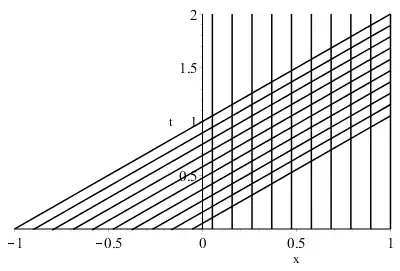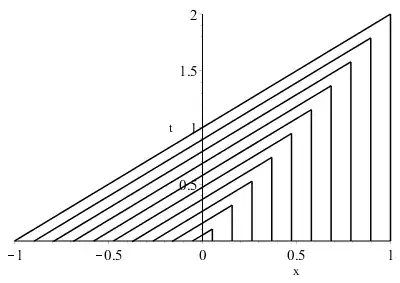So what I'm confused about is how you go about finding shock waves. So suppose we are given the Cauchy problem for Burgers' equation $u_t + uu_x = 0$ with $u(x, 0) = 1$ for $x \le 0$ and $u(x, 0) = 0$ for $x> 0$. Then using method of characteristics we get $x = x_0 + t$ for $x \le 0$ and $x = x_0$ for $x > 0$. How do we then proceed, given that the characteristic lines will intersect so there is no unique $x_0$ such that $(x, t)$ are on only one characteristic line?
2 Answers
Here is a sketch of the characteristic curves in the $x$-$t$ plane, which equation is given by $$ \begin{aligned} x'(t) &= u(x(t),t) \\ &= u(x(0),0) \end{aligned} $$ Those curves intersect already at time zero:
Thus, a shock wave arises.
The Burgers' equation is rewritten in the conservative form $u_t + f(u)_x = 0$, where $f(u) = \frac{1}{2}u^2$. The shock wave with speed $s$, left state $u_L = 1$ and right state $u_R = 0$ writes $$ u(x,t) = \left\lbrace \begin{aligned} &1 &&\text{if}\quad x<st \\ &0 &&\text{if}\quad st<x \, . \end{aligned} \right. $$ The speed of shock must satisfy the Rankine-Hugoniot condition $s = \frac{f(u_R) - f(u_L)}{u_R - u_L}$, i.e. $s = \frac{1}{2}$. Here is a modified sketch of the $x$-$t$ plane, which accounts for the shock:
- 20,898
Follow the method in http://en.wikipedia.org/wiki/Method_of_characteristics#Example:
$\dfrac{dt}{ds}=1$ , letting $t(0)=0$ , we have $t=s$
$\dfrac{du}{ds}=0$ , letting $u(0)=u_0$ , we have $u=u_0$
$\dfrac{dx}{ds}=u=u_0$ , letting $x(0)=f(u_0)$ , we have $x=u_0s+f(u_0)=ut+f(u)$ , i.e. $u=F(x-ut)$
$u(x,0)=\begin{cases}1&\text{when}~x\leq0\\0&\text{when}~x>0\end{cases}$ :
$\therefore u=\begin{cases}1&\text{when}~x-ut\leq0\\0&\text{when}~x-ut>0\end{cases}=\begin{cases}1&\text{when}~x-t\leq0\\0&\text{when}~x>0\end{cases}=\begin{cases}1&\text{when}~x\leq t\\0&\text{when}~x>0\end{cases}$
Hence $u(x,t)=\begin{cases}1&\text{when}~x\leq t\\0&\text{when}~x>0\\c&\text{otherwise}\end{cases}$
- 16,178
- 3
- 31
- 75
-
This is my exact problem. What is the value of $u(5, 6)$? 0 or 1? And what's $c$? – user137302 Apr 13 '14 at 00:10
-
@user137302, both. $c$ is an arbitrary constant. – doraemonpaul Apr 13 '14 at 00:42
-
1@user137302 Note that the method of characteristics can only be used until characteristic curves cross (see my answer for details). – EditPiAf Dec 04 '17 at 10:25

